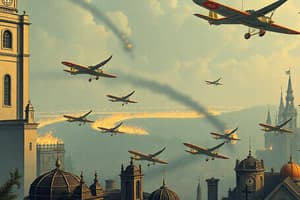Podcast
Questions and Answers
What was the primary objective of the Allied forces during the Dieppe Raid?
What was the primary objective of the Allied forces during the Dieppe Raid?
To test the feasibility of a major cross-channel invasion.
What was the significance of the Battle of Britain?
What was the significance of the Battle of Britain?
It was the first major campaign to be fought entirely by air forces, and the British Royal Air Force (RAF) successfully defended the skies over Britain.
What was the turning point of the Battle of Stalingrad?
What was the turning point of the Battle of Stalingrad?
The Soviet counterattack in November 1942, which led to the encirclement and eventual surrender of the German Sixth Army.
What was the primary objective of the Allied forces during the D-Day invasion?
What was the primary objective of the Allied forces during the D-Day invasion?
What was the outcome of the Battle of Hong Kong?
What was the outcome of the Battle of Hong Kong?
What provoked the Battle of Britain, and how did it unfold?
What provoked the Battle of Britain, and how did it unfold?
What led to the disastrous outcome of the Dieppe Raid, and what were its consequences?
What led to the disastrous outcome of the Dieppe Raid, and what were its consequences?
What triggered the Italian Campaign, and what were its key objectives?
What triggered the Italian Campaign, and what were its key objectives?
What sparked the Battle of Hong Kong, and what were the consequences of the battle?
What sparked the Battle of Hong Kong, and what were the consequences of the battle?
What led to the Dunkirk evacuation, and what were its consequences?
What led to the Dunkirk evacuation, and what were its consequences?
Flashcards are hidden until you start studying
Study Notes
World War II Battles
- Dieppe: Started on August 19, 1942, as a major Allied assault on the German-occupied French port of Dieppe, with the main objective of testing the feasibility of a cross-channel invasion of Nazi-occupied France.
Canadian Forces
- Royal Canadian Airforce: Played a crucial role in the Battle of Britain, providing air support to the Allies.
- Royal Canadian Navy: Contributed significantly to the Allied war effort, particularly in the Battle of the Atlantic, protecting convoys and fighting against German U-boats.
European Theaters
- Liberation of Netherlands: Started in September 1944, as Allied forces, including Canadian troops, pushed into the Netherlands, liberating major cities and eventually freeing the country from German occupation.
- Stalingrad/Moscow: Began in July 1942, as a major German offensive against the Soviet Union, with the Battle of Stalingrad (August 1942 to February 1943) marking a crucial turning point in the war on the Eastern Front.
- Italian Campaign: Started in July 1943, as Allied forces, including Canadian troops, launched a series of amphibious landings and battles to liberate Italy from German occupation.
Early War Battles
- Battle of Britain: Began in July 1940, as a series of air battles between the German Luftwaffe and the British Royal Air Force, marking a crucial turning point in the war as the British successfully defended their skies.
- Dunkirk: Started on May 26, 1940, as a massive evacuation of Allied troops from the beaches of Dunkirk, France, following the German invasion of France and the Low Countries.
Pacific Theater
- Battle of Hong Kong: Began on December 8, 1941, as Japanese forces attacked the British colony of Hong Kong, which eventually fell on Christmas Day, 1941.
D-Day and Normandy
- D-Day: Started on June 6, 1944, as Allied forces, including Canadian troops, launched a massive amphibious invasion of Nazi-occupied France, marking a crucial turning point in the war on the Western Front.
World War II Battles
- Dieppe: Started on August 19, 1942, as a major Allied assault on the German-occupied French port of Dieppe, with the main objective of testing the feasibility of a cross-channel invasion of Nazi-occupied France.
Canadian Forces
- Royal Canadian Airforce: Played a crucial role in the Battle of Britain, providing air support to the Allies.
- Royal Canadian Navy: Contributed significantly to the Allied war effort, particularly in the Battle of the Atlantic, protecting convoys and fighting against German U-boats.
European Theaters
- Liberation of Netherlands: Started in September 1944, as Allied forces, including Canadian troops, pushed into the Netherlands, liberating major cities and eventually freeing the country from German occupation.
- Stalingrad/Moscow: Began in July 1942, as a major German offensive against the Soviet Union, with the Battle of Stalingrad (August 1942 to February 1943) marking a crucial turning point in the war on the Eastern Front.
- Italian Campaign: Started in July 1943, as Allied forces, including Canadian troops, launched a series of amphibious landings and battles to liberate Italy from German occupation.
Early War Battles
- Battle of Britain: Began in July 1940, as a series of air battles between the German Luftwaffe and the British Royal Air Force, marking a crucial turning point in the war as the British successfully defended their skies.
- Dunkirk: Started on May 26, 1940, as a massive evacuation of Allied troops from the beaches of Dunkirk, France, following the German invasion of France and the Low Countries.
Pacific Theater
- Battle of Hong Kong: Began on December 8, 1941, as Japanese forces attacked the British colony of Hong Kong, which eventually fell on Christmas Day, 1941.
D-Day and Normandy
- D-Day: Started on June 6, 1944, as Allied forces, including Canadian troops, launched a massive amphibious invasion of Nazi-occupied France, marking a crucial turning point in the war on the Western Front.
Studying That Suits You
Use AI to generate personalized quizzes and flashcards to suit your learning preferences.




